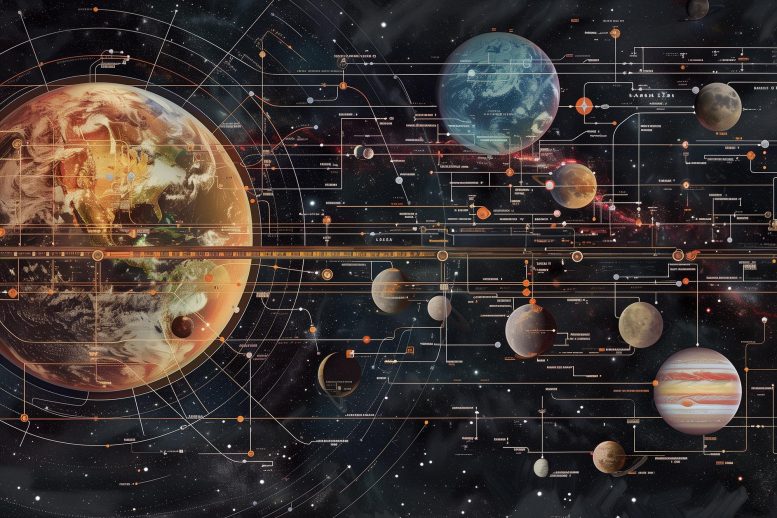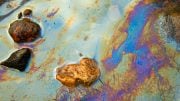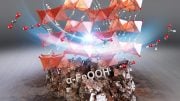
The University of Surrey has introduced a new mathematical method to optimize space mission routes, enhancing efficiency by reducing the need for fuel and extensive computations. This innovative approach, likened to a “tube map for space,” has been successfully applied to missions targeting the Moon and Jupiter’s moons. Credit: SciTechDaily.com
A novel mathematical technique from the University of Surrey now simplifies space mission planning by mapping efficient routes, akin to a subway map, potentially revolutionizing travel to the Moon and beyond.
Just as sat-nav did away with the need to argue over the best route home, scientists from the University of Surrey have developed a new method to find the optimal routes for future space missions without the need to waste fuel.
The new method uses mathematics to reveal all possible routes from one orbit to another without guesswork or using enormous computer power.
Development of the New Route-Finding Method
Danny Owen, who developed the technique at the Surrey Space Center, said:
“Previously, when the likes of NASA wanted to plot a route, their calculations relied on either brute force or guesswork.
“Our new technique neatly reveals all possible routes a spacecraft could take from A to B, as long as both orbits share a common energy level.
“This makes the task of planning missions much simpler. We think of it as a tube map for space.”
Enhancing Fuel Efficiency in Space Missions
In recent decades, space missions have increasingly relied on the ability to change the course of a satellite’s path through space without using fuel.
One way of doing this is to find ‘heteroclinic connections’ – the paths that allow spacecraft to transfer from one orbit to another without using fuel.
The mathematics for finding these paths is complex – usually calculated by using vast computing power to churn through one option after another or by making an ‘intelligent guess’ and then investigating it further.
Introduction of Knot Theory in Space Travel
This new technique uses an area of maths called knot theory to quickly generate rough trajectories – which can then be refined. By doing so, space agencies can gain a full list of all possible routes from a designated orbit. They can then choose the one that best suits their mission – much as you might choose a route by studying the tube map.
The technique was tested successfully on various planetary systems – including the Moon, and the Galilean moons of Jupiter. Both of these are the focus of current and future missions.
Broader Implications and Future Applications
Dr. Nicola Baresi, Lecturer in Orbital Mechanics at the University of Surrey, said:
“Spurred on by NASA’s Artemis programme, the new Moon race is inspiring mission designers around the world to research fuel-efficient routes that can better and more efficiently explore the vicinity of the Moon.
“Not only does our technique make that cumbersome task more straightforward, but it can also be applied to other planetary systems, such as the icy moons of Saturn and Jupiter.”
The paper is published in the journal Astrodynamics.
Reference: “Applications of knot theory to the detection of heteroclinic connections between quasi-periodic orbits” by Danny Owen, and Nicola Baresi, 15 April 2024, Astrodynamics.
DOI: 10.1007/s42064-024-0201-0









Greetings to you who were always in the forefront in space, but why don’t they make any effort on earth, scientists and archaeologists, all the works of human life who worked hard and exhaustingly on the continents for tens of thousands of years with simple devices with the smallest changes of humans before us, our God is the islands And they created the continents, seas and land with the smallest changes for us in the form of animals and dinosaurs, but they brought bad news. They didn’t take the time to draw the continents accurately in the shape of humans and the American continent in the shape of a flying dinosaur, but why do we humans ignore these important issues because humans are involved in life and there are very few people who have worked on these issues as much as us. and thought that on the other side, three thousand meters of soil hides everything and everything is ruined
On the other hand, in the last moments when the meteorites cut the bodies of the dinosaurs in the islands and ocean waters, after the meteor shower, the waves of the dinosaur bodies were directed towards the shores and turned into fossils, but the humans were hidden underground in the continents. and at that time they were stuck underground in their shelters and were crushed underground, and the bodies of those dinosaurs that were previously driven to the shores were buried under three thousand and one meters. They were oiled half a mile underground
Al Einstein, most consider the greatest mind since Moses, said eventually God does not play dice with the Universe. Yes. However, the Universe plays dice with its inhabitants. I’d have been a herbivore I bet like brontosaurus or something.
I thank our young friend for leaving his comment below mine, but it wouldn’t be bad if he explained more, it’s not always the case that those who know more talk less